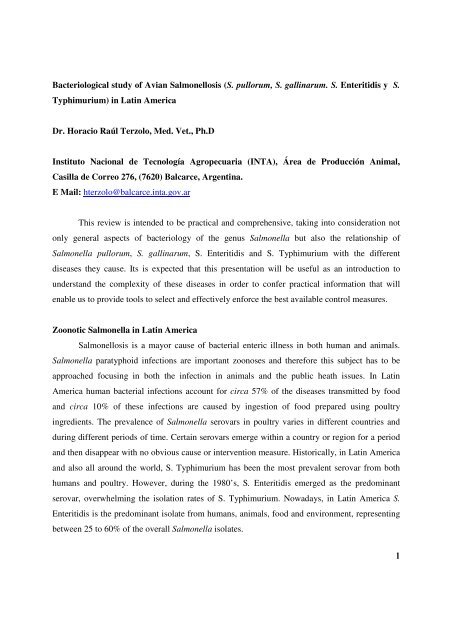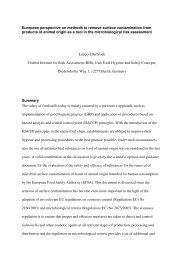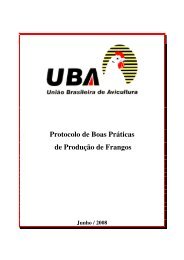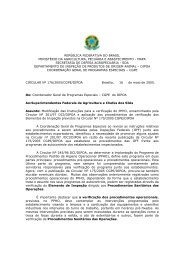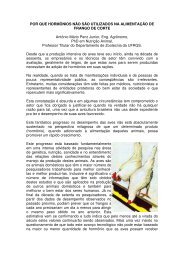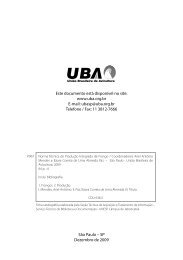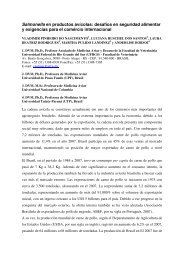1 Bacteriological study of Avian Salmonellosis (S. pullorum, S ... - Abef
1 Bacteriological study of Avian Salmonellosis (S. pullorum, S ... - Abef
1 Bacteriological study of Avian Salmonellosis (S. pullorum, S ... - Abef
You also want an ePaper? Increase the reach of your titles
YUMPU automatically turns print PDFs into web optimized ePapers that Google loves.
<strong>Bacteriological</strong> <strong>study</strong> <strong>of</strong> <strong>Avian</strong> <strong>Salmonellosis</strong> (S. <strong>pullorum</strong>, S. gallinarum. S. Enteritidis y S.<br />
Typhimurium) in Latin America<br />
Dr. Horacio Raúl Terzolo, Med. Vet., Ph.D<br />
Instituto Nacional de Tecnología Agropecuaria (INTA), Área de Producción Animal,<br />
Casilla de Correo 276, (7620) Balcarce, Argentina.<br />
E Mail: hterzolo@balcarce.inta.gov.ar<br />
This review is intended to be practical and comprehensive, taking into consideration not<br />
only general aspects <strong>of</strong> bacteriology <strong>of</strong> the genus Salmonella but also the relationship <strong>of</strong><br />
Salmonella <strong>pullorum</strong>, S. gallinarum, S. Enteritidis and S. Typhimurium with the different<br />
diseases they cause. Its is expected that this presentation will be useful as an introduction to<br />
understand the complexity <strong>of</strong> these diseases in order to confer practical information that will<br />
enable us to provide tools to select and effectively enforce the best available control measures.<br />
Zoonotic Salmonella in Latin America<br />
<strong>Salmonellosis</strong> is a mayor cause <strong>of</strong> bacterial enteric illness in both human and animals.<br />
Salmonella paratyphoid infections are important zoonoses and therefore this subject has to be<br />
approached focusing in both the infection in animals and the public heath issues. In Latin<br />
America human bacterial infections account for circa 57% <strong>of</strong> the diseases transmitted by food<br />
and circa 10% <strong>of</strong> these infections are caused by ingestion <strong>of</strong> food prepared using poultry<br />
ingredients. The prevalence <strong>of</strong> Salmonella serovars in poultry varies in different countries and<br />
during different periods <strong>of</strong> time. Certain serovars emerge within a country or region for a period<br />
and then disappear with no obvious cause or intervention measure. Historically, in Latin America<br />
and also all around the world, S. Typhimurium has been the most prevalent serovar from both<br />
humans and poultry. However, during the 1980’s, S. Enteritidis emerged as the predominant<br />
serovar, overwhelming the isolation rates <strong>of</strong> S. Typhimurium. Nowadays, in Latin America S.<br />
Enteritidis is the predominant isolate from humans, animals, food and environment, representing<br />
between 25 to 60% <strong>of</strong> the overall Salmonella isolates.<br />
1
Salmonella is a ubiquitous environmental bacterium<br />
It has to be pointed out the increasing importance <strong>of</strong> Salmonella contamination <strong>of</strong> foods<br />
prepared with crops, vegetables and seeds, among other foods prepared from plants; the<br />
contamination <strong>of</strong> soybeans and especially soybean meal in bulk that is transported by ship is a<br />
serious worldwide problem that becomes very relevant because this product is the basis <strong>of</strong> many<br />
balanced foods destined to feed various domestic animal species including poultry. Salmonella is<br />
hugely widespread because is able to grow between 7 and 45°C, is only destroyed at 65°C during<br />
10 to 15 minutes, resists very acid pH (even below 4), resists salt added in food up to 20%,<br />
survives in frozen food, remains viable during years in the environment and in certain foods is<br />
able to survive during years (for instance in honey), etc. Bacteria from the Salmonella Genus<br />
make up a versatile and fascinating group <strong>of</strong> microorganisms that are successfully adapted to live<br />
in very different environmental conditions and some <strong>of</strong> them are also adapted to colonize<br />
different animal hosts. In each ecological niche Salmonella will develop different phenotypical<br />
adaptations; for instance if the bacteria live in a river many flagella will be developed to allow<br />
movement <strong>of</strong> the microorganisms in a liquid medium but if they need to grow over a kitchen<br />
chopping board they will have no flagella but instead will be organized into bi<strong>of</strong>ilms, which are<br />
very resistant to mechanic cleaning and disinfection.<br />
Bi<strong>of</strong>im formation<br />
The ability <strong>of</strong> Salmonella to form complex surface-associated communities, called<br />
bi<strong>of</strong>ilms, contributes to its resistance and persistence in both host and non-host environments and<br />
is especially important in food processing environments. Salmonella can be attached to different<br />
types <strong>of</strong> abiotic (plastic, glass, cement, rubber, and stainless steel) or biotic surfaces (plant<br />
surfaces, epithelial cells, and gallstones) as well as plastics used in the laboratory (polystyrene).<br />
Different structural components <strong>of</strong> Salmonella are involved in bi<strong>of</strong>ilm formation: curli and other<br />
fimbriae, protein BapA, flagella, cellulose, colanic acid, anionic O-antigen, capsule and fatty<br />
acids. Bi<strong>of</strong>ilm formation is strongly influenced by different environmental signals via a complex<br />
regulatory network. Bi<strong>of</strong>ilm formation allows Salmonella to resist against different stress factors<br />
such as desiccation or disinfectants (e.g. hypochlorite, glutaraldehyde, cationic tensides and<br />
2
triclosan) and also some antibiotics (e.g. cipr<strong>of</strong>loxacin). Dome bi<strong>of</strong>ilm inhibitors may be used<br />
such as surfactin, glucose, halogenated furanones, 4(5)-aryl 2-aminoimidazoles, furocoumarins<br />
and salicylates. Also it is possible to combine therapy and disinfection (e.g. combinations <strong>of</strong><br />
triclosan and quaternary ammonium salts or halogenated furanones and treatments<br />
antibiotics/disinfectants) and micro-emulsions such as soybean oil-in water. The halogenated<br />
furanones are secreted by various algae and plants and specifically act by interfering with quorum<br />
sensing.<br />
Fowl Typhoid and Paratyphoid infections in Latin America<br />
Most countries in Latin America have combined problems <strong>of</strong> <strong>Salmonellosis</strong> due to S.<br />
Gallinarum (Fowl Typhoid) and S. Enteritidis (Paratyphoid) in laying hens, though in breeders<br />
Paratyphoid usually has sporadic presentations and outbreaks are generally quickly controlled. In<br />
the broiler industry, S. Enteritidis and S. Typhimurium are only sporadically encountered,<br />
although other serovars may be found in either slaughter houses or chicken carcasses in retail<br />
shops. There is more available information on human alimentary outbreaks, some <strong>of</strong> them related<br />
with consumption <strong>of</strong> food from poultry origin.<br />
The presence <strong>of</strong> Fowl Typhoid does not assure that the farm should be free from Paratyphoid<br />
salmonellas as both diseases in the same farm have been simultaneously found.<br />
The Kauffmann – White scheme<br />
Species and subspecies <strong>of</strong> Salmonella are phenotypically classified using different<br />
bacterial growth and biochemical tests while serovars or serotypes are classified according to the<br />
Kauffmann – White scheme. First the "O" antigen type is determined based on polysaccharides<br />
associated with lipopolysaccharides (LPS); the different “O” antigens are expressed by numbers<br />
at the beginning <strong>of</strong> the antigenic formula. Then the "H" antigens are determined based on<br />
flagellar proteins. Since Salmonella exhibit phase variation, exist either mon<strong>of</strong>asic (single phase)<br />
or bifasic (double phase) strains; besides there are non-motile and motile phenotypes and the<br />
latter can express different "H" antigens. S. Gallinarum is always non-motile but retains the<br />
genetic material coding for flagella and even a flagellar hook-basal body complex is seen by<br />
electron microscopy, the protein is called “FliE”. Non-motile isolates can be induced to switch to<br />
3
the motile phase by means <strong>of</strong> cultures in Craigie tubes and also these tubes may be used to detect<br />
a strain that is biphasic although unable to express one <strong>of</strong> the flagellar phases. The flagellar<br />
antigens are expressed by combining letters and numbers. Pathogenic strains <strong>of</strong> S. Typhi as well<br />
as some strains <strong>of</strong> S. Dublin carry the "Vi" antigen (Vi for virulence), which is related to a<br />
protein capsule. Different variations <strong>of</strong> the strains may affect the serotyping results: S – R<br />
(Smooth – Rough), M – N (Mucoid – Non-mucoid), form variations such as “L phase” when the<br />
LPS are lost and the salmonella after loosing its cell-wall acquires a spheroplast shape, fimbriate<br />
– Non-fimbriate, OH – O (Motile – Non-motile), and Monophasic – Biphasic flagellar antigen.<br />
Salmonella species, subspecies and serovars<br />
New serovars are constantly added to the list. Nevertheless only two bacterial species are<br />
actually recognized within the Genus: S. enterica ( 2,443 serovars) and S. bongori (20 serovars).<br />
S. enterica is composed by six subspecies: enterica, salamae, arizonae, diarizonae, houtenae and<br />
indica. Nearly all pathogenic species from warm-blooded animals are included into Salmonella<br />
enterica subsp. enterica (1,454 serovars). The rest <strong>of</strong> the other Salmonella enterica subspp. (989<br />
serovars) either colonize cold-blooded animals or are environmental free-living salmonellas,<br />
excepting some serovars <strong>of</strong> S. enterica subsp. arizonae that may cause disease (Arizonosis) in<br />
turkeys.<br />
Groups <strong>of</strong> Salmonella according to their host prevalence<br />
The majority <strong>of</strong> outbreaks <strong>of</strong> <strong>Salmonellosis</strong> in humans and domestic animals are caused<br />
by relatively few serovars and these serovars can be divided into three groups on the basis <strong>of</strong> host<br />
prevalence. The first group consists <strong>of</strong> host-specific serovars that cause systemic diseases in a<br />
limited number <strong>of</strong> phylogenetically related species. Examples <strong>of</strong> these serovars are the serovar S.<br />
Gallinarum (which includes biovars S. gallinarum and S. <strong>pullorum</strong>) in poultry, S. Typhi and S.<br />
Paratyphi A in humans, S. Typhi-suis in pigs, S. abortus-ovis in sheep, and S. abortus-equi in<br />
horses. All these animal-adapted or human-adapted specific serovars cause disease in only certain<br />
animal species or humans but causes no gastroenteric disease in humans by cross-infection <strong>of</strong><br />
Salmonella species adapted to an animal and therefore are not considered to be zoonotic serovars.<br />
A an exception, a scientific paper described a human empyema caused by S. gallinarum in an<br />
4
immuno-compromised person; nevertheless healthy and immuno-competent human beings are<br />
completely refractory to any disease caused by S. gallinarum.<br />
The second group consists <strong>of</strong> two host-restricted serovars (S. Dublin in cattle species and<br />
S. cholerae-suis in porcine species), however, these serotypes are potentially capable <strong>of</strong> infecting<br />
other animal species and humans.<br />
The third group consists <strong>of</strong> widespread serovars <strong>of</strong> Salmonella enterica subsp. enterica,<br />
such as S. Enteritidis and S. Typhimurium that usually causes gastroenteritis in a wide range <strong>of</strong><br />
unrelated host species. Originally these two serovars are specifically adapted to infect rodents but<br />
also have developed the ability to infect other animal species, including humans. Originally these<br />
two serovars were in fact rodent-adapted specific serovars that evolved capacity to infect other<br />
species, among them human beings.<br />
Host susceptibility to S. Enteritidis and S. Typhimurium<br />
Regarding the susceptibility <strong>of</strong> S. Enteritidis and S. Typhimurium for different animal<br />
species we can state that rodents and humans are the most susceptible, followed by ruminants and<br />
horses as having an intermediate susceptibility and, interestingly, aves, carnivorous mammal<br />
species and pigs are the less susceptible animals. That birds and poultry are one <strong>of</strong> the less<br />
susceptible animal species to acquire any detectable illness makes these animals more relevant as<br />
unapparent carriers <strong>of</strong> paratyphoid salmonellas; as <strong>of</strong>ten both serovars remain unnoticed, they<br />
may have more chances to infect humans throughout consumption <strong>of</strong> contaminated food products<br />
or processed food products. Furthermore, the world increase <strong>of</strong> the consumption <strong>of</strong> poultry<br />
products means more opportunities for these ubiquitous serovars to infect humans.<br />
Maternal immunity and development <strong>of</strong> disease<br />
Very young chicks, less than 2 or 3 days old, are vulnerable to get a paratyphoid evident<br />
disease due to Salmonella septicemia; according to the maternal immunity passively transferred<br />
from their breeder parent flock, the chick progeny may or not be prone to suffer different<br />
mortality rates. Nowadays, as most breeder flocks are vaccinated with inactivated S. Enteritidis,<br />
vaccines, either alone or combined with S. Typhimurium, nearly all flocks have some protective<br />
degree provided by maternal antibodies that usually hides any symptoms becoming the disease<br />
5
clinically unapparent. When during the 1980’s the pathogenic S. Enteritis PT4 or its related PT34<br />
appeared for the first time in naïve broiler breeder flocks <strong>of</strong> Argentina, mortality and disease<br />
signs became apparent. Such symptoms consisted <strong>of</strong> an uneven chicken growth together with a<br />
dwarfness appearance among some <strong>of</strong> the chickens <strong>of</strong> the flock, incomplete resorption and<br />
induration <strong>of</strong> the yolk sac and variable mortality rates, which may reached up to 10% in the first<br />
batch <strong>of</strong> chicks that were hatched from naïve unvaccinated broiler breeder flocks. Interestingly,<br />
as maternal immunity increased in the broiler-breeder parent flock, the successive batches <strong>of</strong><br />
hatched chicks <strong>of</strong> the corresponding progeny gradually diminished the symptoms and lesions as<br />
well as the mortally rates, until complete disappearance after the two weeks.<br />
S. Enteritidis and S. Gallinarum are clonally related<br />
Comparative genome analysis between S. Enteritidis and S. Gallinarum indicated that<br />
both serovars are highly related and they probably share genes that might be acquired from a<br />
common primitive bacterium ancestor. The close relationship between the poultry-adapted S.<br />
Gallinarum and S. Enteritidis signify that the latter possesses some factors that made the serovar<br />
Gallinarum successful as poultry pathogen. Both isolates belong to serogroup D1, indicating that<br />
the structure <strong>of</strong> their LPS is very similar. Both serovars are part <strong>of</strong> the same clonal lineage, have<br />
the same mechanisms <strong>of</strong> intracellular multiplication and both possess SEF14 fimbriae, which is<br />
strongly involved in the colonization <strong>of</strong> the reproductive tissues. Therefore, acquisition <strong>of</strong> SEF14<br />
was critically important to allow S. Enteritidis a successful colonization <strong>of</strong> the eggs.<br />
Diagnosis methods<br />
There are in the market many very efficient culture media and techniques to isolate<br />
Salmonella spp. from poultry, food or environmental samples. Different isolation techniques have<br />
been described including non-selective and selective enrichment broths and different agars to<br />
identify and pick Salmonella-like colonies. Non-selective enrichment broths include peptone<br />
water and lactose broth. The most common selective enrichment broths are Salmocyst®,<br />
Tetrationate, Rappaport Vassiliadis and Selenite-cystine. For most paratyphoid Salmonella<br />
Xilose-Lisine-Deoxycholate, Salmonella-Shigella, Hektoen Enteric or Rambach agars are all<br />
suitable for detection and isolation <strong>of</strong> Salmonella colonies. As the colonies <strong>of</strong> S. Gallinarum are<br />
6
smaller than those from other Salmonella enterica serovars, faintly produce SH2 and usually may<br />
be isolated in abundant pure culture from the organs <strong>of</strong> diseased birds, usage <strong>of</strong> MacConkey agar<br />
for primary isolation <strong>of</strong> Fowl Typhoid outbreaks is a very convenient choice. Batteries <strong>of</strong> cultures<br />
and biochemical tests are used to phenotypically characterize the isolates. For a rapid screening<br />
<strong>of</strong> Salmonella spp. in food or food ingredients, a rapid ELISA test is commercially available.<br />
Now there are also available in the market molecular tests designed for identification <strong>of</strong> some<br />
most common pathogenic serovars <strong>of</strong> Salmonella enterica. These molecular methods have the<br />
advantage to overcome some <strong>of</strong> the aforementioned variations <strong>of</strong> the Salmonella strains that may<br />
affect the classical serotyping results.<br />
Sampling methods<br />
The most appropriate samples for septicemic cases due to fowl typhoid or paratyphoid<br />
Salmonella outbreaks are: liver, gallbladder with bile contents and spleen. All Salmonella spp.<br />
are able to survive an even grow in pure bile, sometimes developing adherent bi<strong>of</strong>ilms into the<br />
gallbladder walls. Caecum contents are always suitable to isolate paratyphoid Salmonella but it is<br />
not always a good sample to isolate S. Gallinarum because in acute outbreaks <strong>of</strong> diseased birds<br />
frequently die before the intestine is being colonized. Bone marrow from tarsus-metatarsus is the<br />
best choice when the bird is found already dead from Fowl Typhoid. Cloacal swabs from adult<br />
birds are not always the best sample because most <strong>of</strong> the times excretion is intermittent. On the<br />
contrary, sampling meconium by pressing the belly <strong>of</strong> 1-day-old chickens is the best sample to be<br />
taken. Sometimes it is very difficult to isolate Salmonella enterica from the organs or feces from<br />
infected breeders; in such cases it is better to cultivate samples from the chick progeny rather<br />
than from their parents. When autopsy from very young chicks is undertaken, in addition to<br />
meconium, egg-yolk sac and livers are also excellent samples. Cultures <strong>of</strong> environmental samples<br />
from farms, hatcheries, and slaughterhouses as well as different implements for poultry rearing or<br />
work with birds are important to know the extent <strong>of</strong> contamination and to take preventive<br />
measures, but it has to be taken in account that other environmental serovars which are not<br />
involved in the disease <strong>of</strong> the birds may also be isolated.<br />
Drawbacks <strong>of</strong> the whole blood agglutination test<br />
7
During many years the rapid whole blood stained S. Pullorum antigen was used in farms<br />
as a practical agglutination test to eradicate Fowl Typhoid by elimination <strong>of</strong> the positive reacting<br />
birds. Nowadays, due to the widespread <strong>of</strong> the pathogenic S. Enteritidis within the poultry<br />
industry, most breeders are vaccinated with inactivated vaccines based on S. Enteritidis and,<br />
because Enteritidis and S. Gallinarum share common antigens, these birds may develop<br />
antibodies that react against both serovars. Sometimes when the birds <strong>of</strong> the farm are infected<br />
with S. Enteritidis and the animals are free from S. Gallinarum, some chickens may be erratically<br />
positive to the whole blood <strong>pullorum</strong> test. In addtion, some outbreaks <strong>of</strong> Fowl Typhoid may be<br />
caused by a S. gallinarum strain that have antigenic differences with the standard or variable S.<br />
<strong>pullorum</strong> strains used to formulate the antigen; in this case only a few infected birds may be<br />
detected as positive reactors. Besides, it has also to take into account that some<br />
Enterobacteriaceae share common antigens with Salmonella spp., such as some strains <strong>of</strong><br />
Escherichia coli (named “Salmonella coli”); these strains may cause a relatively high rate <strong>of</strong> false<br />
positive reacting birds even if the farm is free from Fowl Typhoid. It should be then indicated<br />
that this test has only a bird’s population value and do not has any individual value; hence these<br />
results should be interpreted very carefully because the final diagnosis must be based on the<br />
isolation the <strong>of</strong> causative Salmonella spp.<br />
Relationship among Salmonella virulence, chicken rearing and environmental conditions<br />
The nature and severity <strong>of</strong> Salmonella infections varies enormously and is influenced by many<br />
factors: infecting Salmonella serovar, virulence <strong>of</strong> the strain, infecting dose, age and immune<br />
status <strong>of</strong> the bird, management <strong>of</strong> the flock and biosecurity measures and also has to be taken into<br />
account the geographical region were the farm is located and the climate conditions. The genetic<br />
background <strong>of</strong> bird is also important, although to a lesser degree. It is paramount to consider the<br />
virulence factors <strong>of</strong> the serovar and also the attributes <strong>of</strong> virulence that carries and expresses the<br />
infecting strain. Among them we have to consider: cellular wall with its LPS, cellular membrane<br />
with its proteins, thermolabile enterotoxin (LT), cytotoxin, flagella, pili or fimbriae and also the<br />
DNA that carries virulence determinants either in the chromosome or plasmids.<br />
8
Mutations and genetic interchange <strong>of</strong> Salmonella<br />
Because the generation time <strong>of</strong> Salmonella only lasts circa 22 minutes, duplication <strong>of</strong><br />
bacteria is very fast. Such a rapid genetic duplication <strong>of</strong> the bacterial DNA gives chances to the<br />
bacterium to relatively quickly acquire genetic changes, either due to mutations or genetic<br />
interchange. Genetic interchange may take place by transformation or transference <strong>of</strong> free DNA,<br />
transduction or transference by means <strong>of</strong> specific Salmonella bacteriophages and conjugation in<br />
which either genetic material from the chromosome or the plasmids may be transferred by a<br />
sexual pillus from the donor to the recipient bacillus.<br />
Phagetyping<br />
Phagetyping has for decades been useful as a phenotypical, definitive method for<br />
epidemiological characterization <strong>of</strong> Salmonella Typhimurium. Phagetyping has also been very<br />
useful to classify strains <strong>of</strong> Salmonella Enteritidis from different regions; for instance, it was<br />
found that in Europe predominates phagetype (PT) 1, 4 and 6, in USA PT8, in Spain PT14b and<br />
in Argentina PT4 and its variants PT34 (from very virulent strains) and PT7 (from low virulent<br />
strains). The system recommended by the World Health Organization (WHO) Collaborative<br />
Centre for phage typing <strong>of</strong> Salmonella has, however, become rather complex, and there are<br />
challenges <strong>of</strong> sufficient standardization for the interpretation <strong>of</strong> lysis to make sure that the same<br />
strain is assigned to the same phagetype by different laboratories. In the future molecular typing<br />
methods will replace phenotypic characterization methods, but despite <strong>of</strong> that phage typing will<br />
remain for some time as a useful tool for Salmonella surveillance.<br />
Virulence plasmids <strong>of</strong> Salmonella<br />
Pathogenic Salmonella serovars contain autonomously replicating plasmids, being only<br />
some <strong>of</strong> them transferable by conjugation. Some are involved in virulence or harbor antibiotic-<br />
resistance genes, while others are cryptic with no recognized function. Some plasmids have been<br />
sequenced, as for instance the S. Enteritidis 60kb virulence plasmid. Virulence type plasmids<br />
vary between 50 and 100kb and are present in many isolates <strong>of</strong> different Salmonella serovars.<br />
The virulence plasmids have a common ~8kb DNA region encoding the spv genes (spv =<br />
Salmonella plasmid virulence) and are present in pathogenic strains <strong>of</strong> S. Enteritidis, S.<br />
9
Gallinarum (biovars S. gallinarum and S. <strong>pullorum</strong>), S. Typhimurium, S. Cholareasuis, S. Derby,<br />
S. Dublin and S. Paratyphi B. Other Salmonella subspecies such as S. arizonae have the spv genes<br />
included in the chromosome. The spv plasmid is required for the expression in vivo <strong>of</strong> a full<br />
virulence phenotype. Strains that were cured from the spv plasmid loose their capacity to survive<br />
and persist in the host. By means <strong>of</strong> challenge experiments with S. gallinarum in 2 week-old<br />
chickens it was demonstrated the relationship between mortality and presence, absence or<br />
reintroduction <strong>of</strong> the virulence plasmid. Thirty genes <strong>of</strong> the spv plasmid <strong>of</strong> S. Typhimurium<br />
regulates responses to the internal environ and stressful conditions that might be encountered<br />
within the host, including anaerobic growth, nitrogen and phosphate starvation, acid and osmotic<br />
shock and oxidative stress. A well characterized response to environmental stress is the induction<br />
<strong>of</strong> acid tolerance response; previous exposure to low pH (4.4 to 5.8) for a short period <strong>of</strong> time<br />
initiates a bacterial response that increases resistance to even more acidic conditions (pH 3.3 to<br />
3).<br />
Antibiotic multi-resistant Salmonella<br />
The use <strong>of</strong> antibiotics in human and veterinary medicine and crop protection provides a<br />
selection pressure resulting in the preferential spread <strong>of</strong> resistant bacteria. Due to the<br />
aforementioned genetic interchange, some molecular determinants may be selected and<br />
propagated in bacteria, either in the same bacterial species or in other species from genetically<br />
related genus, for instance Salmonella with other Enterobacteriaceae.<br />
Conflicting opinions have been expressed on the large-scale use <strong>of</strong> antibiotics in the<br />
poultry industry. It was believed that banning the extensive use <strong>of</strong> antibiotics in chickens could<br />
reduce the spread <strong>of</strong> antibiotic-resistant bacteria but this action should be accompanied by other<br />
measures because if not it may result in an increase incidence <strong>of</strong> antibiotic resistant Salmonella in<br />
chickens due to an increased requirement <strong>of</strong> treatments. Nevertheless, in some countries with<br />
good biosecurity measures in the farms, as for instance in Denmark, banning <strong>of</strong> antibiotics as<br />
growth promoters in chickens was found beneficial without producing any increase <strong>of</strong> Salmonella<br />
shedding.<br />
The aforementioned virulence plasmid spv encoded genes associated with antibiotic<br />
resistance in S. Typhimurium, S. Dublin and S. Choleraesuis. This plasmid acquired a toxin –<br />
10 1
antitoxin system that ensures its survival. Both toxin and antitoxin are encoded by the plasmid<br />
and the two proteins bind to form a harmless dimmer in the bacterial cell. The antitoxin is labile<br />
but is continually replaced by the gene encoded by the plasmid. If a bacterium loses the plasmid<br />
during bacterial replication, the bacterium will still be intact complex Toxin – Antitoxin but the<br />
antitoxin is continuously deteriorating and can not be replenished, so the toxin is released and<br />
accumulates and eventually the cell lacking the plasmid will die. The problem <strong>of</strong> plasmid<br />
mediated resistance in poultry is mainly limited to some multi-resistant strains <strong>of</strong> S.<br />
Typhimurium that emerged in 1960’s; these strains are resistant to ampicillin, streptomycin,<br />
sulfonamides, tetracyclines, and furazolidone. On the other hand, S. Enteritidis, despite having<br />
the spv plasmid, rarely exhibits genetic acquired antibiotic resistance; its plasmids only confer a<br />
limited resistance phenotype. During 1995-2001 it was undertaken a <strong>study</strong> that included 258 S.<br />
gallinarum strains; it was demonstrated an augmented resistance for some antibiotics which had<br />
been increasingly used and a diminished resistance for others that had been either completely<br />
withdrawn from the farms or very sporadically administered.<br />
Pathogenicity islands and virulence<br />
Salmonella have evolved strategies to colonize various anatomical niches <strong>of</strong> the chicken.<br />
The pathogenicity islands are large and distinct entities located on the bacterial chromosome.<br />
They harbor one or more virulence genes. They may be genetically stable or more frequently<br />
unstable due to genetic DNA-mobility by direct repeats, integrases, transposases and<br />
bacteriophages genes. Many <strong>of</strong> these islands contain a %C+G (percentage <strong>of</strong> Cytosine plus<br />
Guanine) that is higher or lower than the core genome. These genes have anchored points <strong>of</strong><br />
tRNA acquired from lisogenic phages. The Salmonella Pathogenic Island 1 (SP-1) is a stable<br />
DNA that is required for invasion <strong>of</strong> non-phagocitic cells allowing the salmonellas to invade the<br />
gut tissues after oral infection. In addtion SP-1 induces apoptosis <strong>of</strong> the macrophages and cleaves<br />
two pro-inflammatory cytokines: interleukin (IL) IL1β and IL18. Both events allow the escape <strong>of</strong><br />
the internalized salmonellas from infected macrophages and at the same time attracts novel<br />
phagocytes; hence the inflammatory focus increases by replication <strong>of</strong> the salmonellas into the<br />
intercellular space and engulfment <strong>of</strong> the free bacillus by the recently arrived phagocytes; by<br />
means <strong>of</strong> apoptosis Salmonella is able to produce new inflammatory focus. Another important<br />
11 1
function <strong>of</strong> SP-1 is the acquisition by Salmonella <strong>of</strong> the combined iron from the internal environ<br />
<strong>of</strong> the chicken, allowing extra-cellular multiplication <strong>of</strong> bacteria within the intercellular spaces <strong>of</strong><br />
the chicken tissues.<br />
SP-2 is necessary for the protection <strong>of</strong> the Salmonella cells contained within an<br />
intracelullar vacuole <strong>of</strong> the bird because it prevents the action <strong>of</strong> the oxidase and nitric oxide,<br />
powerful oxidizing agents that are released by a synthase produced by the phagocyte. Also<br />
encodes for the intracellular translocation <strong>of</strong> effector proteins <strong>of</strong> Salmonella through the<br />
formation <strong>of</strong> tubular aggregates in the endosomes <strong>of</strong> the cells <strong>of</strong> the bird. Another function <strong>of</strong> the<br />
SP-2 is to codify for anaerobic respiration by means <strong>of</strong> the enzyme tetrathionate reductase.<br />
SP-3 encodes for intracellular survival and replication <strong>of</strong> Salmonella within the nutrient<br />
poor environment <strong>of</strong> the vacuoles using limited concentrations <strong>of</strong> purines, pyrimidines, particular<br />
amino acids and Mg 2+ . SP-4 genes encode for the type I secretion system involved in production<br />
<strong>of</strong> bacterial toxins and survival inside macrophages. SP-5, also called “Salmonella Centrisome 7<br />
Genomic Island”, codifies for effector proteins <strong>of</strong> SP-1 and SP-2. SP-6 encodes for fimbriae that<br />
contribute to virulence in S. enterica. SP-7 is also called “Mayor Pathogenicity Island” contains<br />
genetic elements encoding virulence for pili that contribute to invasion <strong>of</strong> epithelial cells and the<br />
Vi polysaccharide capsule <strong>of</strong> S. Typhi, S. Dublin and S. Parayphi C. More research is needed to<br />
know the functions <strong>of</strong> the other islands, some are disclosed as follows: SP-8 encodes for<br />
bacteriocins <strong>of</strong> S. Typhi; SP-9 for a citotoxin <strong>of</strong> S. Typhimurium; and SP-10 for the Sef<br />
adherence fimbriae <strong>of</strong> S. Enteritidis and S. Typhi. Finally “Salmonella Genomic Island 1”<br />
encodes for antibiotic resistance.<br />
Different states <strong>of</strong> Salmonella poultry carriers<br />
After Salmonella infection the birds may remain as carriers for a variable period <strong>of</strong> time or even<br />
for life. S. enterica may remain viable inside macrophages and other cells <strong>of</strong> the Reticulo<br />
Endothelial System. Due to the lisozyme content <strong>of</strong> some tissues from the host the cellular wall<br />
<strong>of</strong> S. enterica may be completely or partially removed forming a protoplast or spheroplast or the<br />
so called “L form”. In this state the bacteria generally remain undetected because do not elicit any<br />
immune response; this is because the bacterial membrane has a composition that is very similar to<br />
the one <strong>of</strong> the avian cell. Also can not be isolated by standard bacteriological methods because<br />
12 1
these procedures lack <strong>of</strong> osmotic protection prior to induce a reversal <strong>of</strong> “L form” (from L Phase<br />
to Vegetative Phase with recovery <strong>of</strong> the cell wall).<br />
Three types <strong>of</strong> carriers are described; Active: Salmonella have in vivo replication and high<br />
numbers <strong>of</strong> bacteria are excreted and heavily contaminate the environment; Passive: Salmonella<br />
is ingested but the bacterium is unable to multiply because <strong>of</strong> the host immune status or because<br />
the bird is refractory to infection for this particular serovar or strain, in such case only the same<br />
clone <strong>of</strong> bacteria that is ingested is excreted; and Latent: the bird does not excrete any salmonella<br />
since intracellular bacteria remain hidden, at which stage the bacterial cultures that are commonly<br />
used to detect the vegetative bacillus <strong>of</strong> Salmonella are all negative, a situation that continues<br />
unabated until the animal is able to excrete bacteria, which usually occurs after a factor <strong>of</strong> stress<br />
reactivates the disease. “Latent Carriers” may be turned into “Active Carriers” by the action <strong>of</strong><br />
different factors <strong>of</strong> stress, such as: transport, overcrowding, entering new birds into the farm,<br />
sudden temperature changes, different climate alterations, food restriction, molting, intense<br />
reproductive activity in breeders, production <strong>of</strong> eggs, and experimentally the stress can be<br />
triggered by injecting corticosteroids.<br />
Vertical transmission<br />
S. Gallinarum, S. Pullorum, S. Enteritidis and S. Typhimurium are the most important<br />
salmonellas that are transmitted through eggs. When this infection reaches a breeder farm, a<br />
serious sanitary problem could be generated because this disease vertical spreads from the parent<br />
flock to its chicken progeny. Moreover, once a pathogenic Salmonella strain is introduced into a<br />
farm it is very difficult to eliminate infection because a single batch <strong>of</strong> infected breeding birds<br />
can contaminate at the hatchery all the chicks from the other lots that so far have not been<br />
infected. For that reason when contamination reaches the breeders the economic cost for the<br />
elimination the disease is very high. Due to this reasons enormous efforts are made to raise<br />
breeders that are free from pathogenic Salmonella. On the other hand, when laying hen farms are<br />
infected with paratyphoid salmonellas, the infection usually becomes clinically unapparent and<br />
the Salmonella can be inadvertently transmitted through eggs for human consumption. Also S.<br />
gallinarum may be present in some farms and in this case the disease becomes clinically evident<br />
and very frequently causes mortality and severe economic loses.<br />
13 1
Contamination <strong>of</strong> eggs by different serovars <strong>of</strong> Salmonella enterica<br />
Some serovars <strong>of</strong> S. enterica subsp. enterica may cause human gastroenteric illness<br />
through food prepared using contaminated undercooked or raw eggs. In USA S. Enteritidis was<br />
described as the most frequent serovar (90%) isolated from table eggs whereas in the EU is the<br />
most common environmental serovar (52%) in laying hen farms. In addition to S. Enteritidis,<br />
other serovars have been described as a cause <strong>of</strong> human <strong>Salmonellosis</strong> due to consumption<br />
contaminated eggs: S. Typhimurium, S. Infantis, S. Hadar, S. Newport, S. Stanley, S. Derby, S.<br />
Agona, S. Kentucky and S. Virchow, among some others. The chicken adapted biovars S.<br />
<strong>pullorum</strong> and S. gallinarum produce a high percentage <strong>of</strong> internally contaminated eggs (circa<br />
6.5%) during the period <strong>of</strong> sexual maturity. On the contrary, S. Enteritidis is less successful,<br />
being the percentage <strong>of</strong> internally contaminated eggs between 0.1% and 0.6 %. In addition to<br />
systemic spread, other serovars <strong>of</strong> Salmonella enterica can also gain access to the oviduct<br />
through ascending infection from the cloacae to the vagina. The rank order <strong>of</strong> the Salmonella<br />
invasiveness in vaginal epithelium is dependent on the LPS type as follows: antigen O9 (S.<br />
Gallinarum, S. Enteritidis) > O4 (S. Typhimurium, S. Heilderberg), O4 > O7 (S. Infantis, S.<br />
Montevideo), and O7 > O8 (S. Hadar).<br />
Virulence factors associated with egg colonization<br />
The process <strong>of</strong> colonization <strong>of</strong> the reproductive tract is complex and depends on many<br />
factors including Sef fimbriae and manose dependent Type 1 fimbriae, flagellae, LPS, cell wall<br />
structure and stress tolerance. S. Enteritidis is the best adapted paratyphoid serovar for the<br />
colonization and persistance in the hen’s reproductive tract and it was demostrated that repeated<br />
in vivo passages <strong>of</strong> a S. Enteritidis strain through the reproductive tissues <strong>of</strong> the hen increases its<br />
ability to induce internal egg contamination, whereas serial in vivo passages through liver or<br />
spleen did not affect the ability <strong>of</strong> the strain to cause internal egg contamination.<br />
Contamination <strong>of</strong> eggs after oviposition<br />
S. Enteritidis can contaminate eggshells and is able to migrate through the shell and<br />
associated membranes thus contaminating the egg contents. This occurs more frequently if the<br />
14 1
eggshell is damaged or may also happen in undamaged recently laid eggs exposed to fecal<br />
contamination <strong>of</strong> salmonellas. The fecal contamination could happen at the moment <strong>of</strong><br />
oviposition when the egg passes through the cloaca in an infected hen or if the egg is kept, for<br />
instance, in a egg-pack, which have been previously used and was contaminated with feces. The<br />
presence <strong>of</strong> chicken manure and other moist organic components in the shell facilitates the<br />
survival and growth <strong>of</strong> Salmonella by providing nutrients and physical protection. Bacteria can<br />
easily penetrate a cracked eggshell. However, the intact egg possesses three physical barriers that<br />
are intended to avoid bacterial penetration: the cuticle over the pore openings, the crystalline<br />
eggshell and the shell membranes. In addition to be a physical barrier the eggshell also acts as<br />
chemical barrier having lisozyme, ovotransferin, avidin, and ovocalixin-36; the latter causes a<br />
bactericidal-permeability increasing effect and belongs to a group <strong>of</strong> specific LPS binding<br />
proteins. Because <strong>of</strong> such complete protection, the intact eggshell is only susceptible to be<br />
penetrated immediately after the egg is laid. During the first few minutes after oviposition, the<br />
cuticle is immature and some <strong>of</strong> the pores may be opened. At this very moment there is thermical<br />
difference between the temperature <strong>of</strong> the recently laid egg and the environment; this difference<br />
generates a negative pressure that sucks the Salmonella towards the inside <strong>of</strong> the egg.<br />
Contamination <strong>of</strong> eggs before oviposition<br />
The other possible routes are by direct contamination <strong>of</strong> the yolk, albumen, egg shell<br />
membranes or the egg shell itself before oviposition. When infections are caused by invasive<br />
Salmonella strains, infected macrophages migrate to the internal organs <strong>of</strong> poultry, particularly to<br />
reproductive tissues: ovary, infundibulum, magnum, isthmus, and shell gland. Up to now all<br />
available research suggests that contamination <strong>of</strong> the egg contents by S. Enteritidis is mainly a<br />
consequence <strong>of</strong> the infection <strong>of</strong> the reproductive tissues. The bacterium is almost always present<br />
in pure culture in the egg contents and different studies have demonstrated that there is no<br />
association between the presence <strong>of</strong> S. Enteritidis on eggshells and egg contents. Furthermore, S.<br />
Enteritidis can be isolated from the reproductive tissues <strong>of</strong> naturally infected hens even in the<br />
absence <strong>of</strong> intestinal carriage. S. Enteritidis is mainly localized in the albumin-secreting region<br />
where they persist for life without harming the hen. Less frequently S. Enteritidis may also infect<br />
ovaries via bloodstream. S. Enteritidis generally does not produce the typical ovary lesions found<br />
15 1
in Fowl Typhoid but exceptionally few hens <strong>of</strong> a flock can have malformed ovules. The small<br />
white immature follicles are more susceptible to S. Enteritidis invasion than the more mature<br />
small and large yellow ones; the penetration <strong>of</strong> immature follicles might lead to contamination <strong>of</strong><br />
eggs after maturation meaning that a very few hens from a flock may have a continuous<br />
transovarian infection <strong>of</strong> eggs lasting the complete reproductive cycle. It was found that S.<br />
Enteritidis is able to colonize ovaries and preovulatory follicles at significant higher level than<br />
other five non-related serovars after intravenous infections. S. Typhimurium may also be able to<br />
colonize the ovaries but to a lesser extent than S. Enteritidis. In fact, S. Enteritidis colonizes more<br />
ovaries and internal organs and these tissues habour more S. Enteritidis than S. Typhimurium per<br />
gram.<br />
16 1


